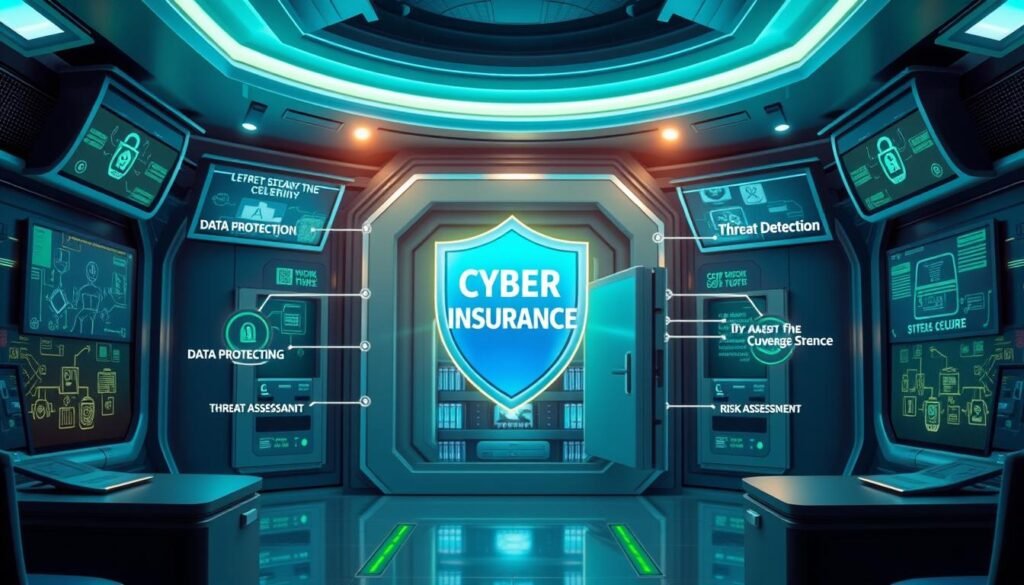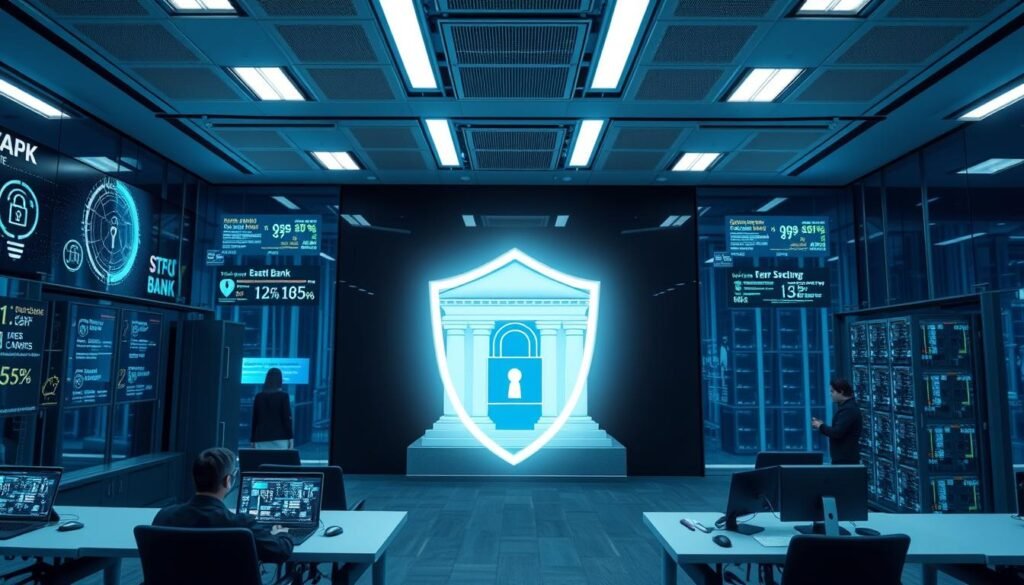In today’s digital world, banks face a big threat from cybercriminals. In the first half of 2022, there were 236.1 million ransomware attacks worldwide. The average cost of a data breach hit a record $4.35 million in 20221. With the FBI getting 847,376 Internet Crime Complaints in 2021, and losses reaching $6.9 billion, ignoring cyber threats is not an option.
The banking sector’s growing reliance on technology makes cyber insurance more critical than ever. Cyber liability insurance offers the protection your institution needs. It covers costs from data breaches and other cyber incidents2. With 50% of companies now having cyber insurance, compared to 34% two years ago2, it’s clear banks must prioritize this risk management tool.
Key Takeaways
- Cyberattacks and data breaches pose significant financial and reputational risks to banks, with the average cost of a breach reaching $4.35 million in 2022.
- Comprehensive cyber insurance can protect your institution by covering the costs of incident response, data restoration, business interruption, and more.
- The banking industry is a prime target for cybercriminals, with 61% of small and mid-sized businesses reporting at least one cyberattack in the previous year.
- Cyber insurance policies are evolving, with carriers requiring higher minimum security controls and increasing premiums due to the rise in malicious cyber activity.
- Proactive cybersecurity measures, such as multi-factor authentication and robust incident response planning, are essential for maintaining coverage and minimizing your cyber risk exposure.
The Need for Cyber Insurance in the Banking Industry
Cybercriminals are now targeting banks more than ever3. This has led to a 39% increase in cyber insurance claims over the last two years3. In 2019, the FBI’s Internet Crime Complaint Center saw 2,047 ransomware complaints, with losses over $8.9 million3.
In 2020, cybercriminals asked for an average of $178,254 in ransom payments per attack, a 60% increase from the first quarter3. Some even asked for over $1 million. It took over 16 days on average to recover from these attacks in Q2 20203.
The Growing Threat of Cyberattacks on Financial Institutions
Banks have valuable data that cybercriminals want, leading to big ransom demands4. The banking industry saw a 1318% increase in ransomware attacks in the first half of 20214. There’s a 38% chance a cyber attack on one bank could hit another nearby due to shared networks4.
The Financial and Reputational Costs of a Cyber Breach
A cyberattack on a bank can lead to big financial losses, damage to reputation, and even losing customers4. In 2019, Capital One faced a major data breach affecting 100 million people in the US. This cost them $80 million and led to many customers leaving4. On average, a data breach costs a bank about $5.72 million4.
About 40% of US companies have cyber insurance3. But, new companies are slowly starting to buy cyber insurance policies3. There’s no law requiring cyber insurance, but it’s wise to talk to a lawyer about any legal or contract needs3.
“Cybercriminals have increasingly targeted the banking industry, posing a growing threat to financial institutions.”
What is Cyber Insurance for Banks?
Cyber insurance, also known as cyber liability insurance, protects banks from cyberattacks and data breaches. It helps banks cover costs and minimize disruption from cyber incidents5.
First-Party and Third-Party Coverage
Cyber insurance for banks has two main types: first-party and third-party5. First-party coverage helps the bank itself, covering legal, data recovery, and crisis management costs5. Third-party coverage protects the bank from claims by others, like customers or vendors, after a cyber incident5.
Cyber insurance for banks covers a wide range of risks6. It includes defense costs, fines, forensic costs, and more6.

Investing in cyber insurance helps banks fight cyber threats6. It’s key for managing cyber risk and protecting the bank’s finances and reputation6.
Key Coverages of a Cyber Insurance Policy
Cyber insurance for banks covers many important areas. It protects against data breaches, cyber attacks on vendors, network issues, global cyber incidents, and terrorism7.
Data Breach Response and Notification Costs
First-party coverage in cyber insurance for banks includes many costs. It covers legal fees for notifications, data recovery, customer service, crisis management, and forensic services7. It also includes fines, penalties, and costs from cyber extortion7.
Business Interruption and System Recovery
Cyber insurance for banks offers business interruption coverage. It helps replace lost income and cover ongoing expenses when a cyber incident stops operations7. It also helps with system and data recovery costs after an attack7.
Cyber Extortion and Ransomware
Banks face risks from cyber extortion and ransomware. Cyber insurance can help with ransom demands, incident response, and remediation costs7.
When choosing cyber insurance, banks should look for policies with a “duty to defend” clause and 24/7 breach hotline support7. These features offer extra peace of mind and help during a cyber crisis.

| Coverage Type | Description |
|---|---|
| Data Breach Response and Notification Costs | Expenses related to legal counsel, data recovery, customer notification, crisis management, and forensic services. Can also cover fines, penalties, and cyber extortion costs7. |
| Business Interruption and System Recovery | Replaces lost income and covers continuing expenses when the bank cannot operate due to a cyber incident. Helps restore systems and recover data7. |
| Cyber Extortion and Ransomware | Covers the negotiation and payment of ransom demands, as well as the costs of incident response and remediation7. |
“Cyber insurance policies for banks should provide complete coverage against the growing cyber threats. This includes data breaches, network disruptions, and cyber extortion.”7
Understanding cyber insurance coverages helps banks protect their operations, reputation, and customer trust. This is vital in the face of increasing cyber risks7.
Assessing Your Cyber Risk Exposure
Figuring out the right cyber insurance for your bank starts with a detailed look at your cyber risk8. You need to know about your bank’s tech setup, how likely you are to get hacked, and where you might be weak. A deep dive into your tech and security can show you where you’re at risk. This is what insurance companies will want to see before they give you a quote.
The National Institute of Standards and Technology (NIST) has a Cybersecurity Framework for checking risks9. Cyber risks are about things that could lead to a data breach, affecting important data, money, or online business9. To figure out your cyber risk, you must know the threats, weak spots, and possible damage from a cyber attack9.
Things that affect how vulnerable you are include spotting threats, checking if you’re open to attack, and knowing the damage if you get hacked9. The formula for cyber risk in your IT setup is: Cyber risk = Threat x Vulnerability x Information Value9. Regular cyber risk checks can save money, keep you in line with rules, and stop data breaches and system downtime9.
Whether you handle cyber risk yourself or outsource it, knowing your data, setup, and data value is key9. You also need to check how you store and access data, set clear goals for your assessment, and create a risk analysis model9. Showing you have a good Third-Party Risk Management (TPRM) program can also get you better insurance deals8.
By actively checking your cyber risk, you can see where your bank is weak and protect it from cyber threats8. A solid cybersecurity plan that includes people, processes, and tech can also make you more appealing to insurers. This could lead to better coverage and prices8.
Implementing Cybersecurity Best Practices
The banking world is constantly facing new cybersecurity challenges. Banks hold a lot of personal and financial data, making them a big target for hackers10. To stay safe, banks need to use strong security measures and keep their defenses up to date.
Multi-Factor Authentication
Using multi-factor authentication (MFA) is a key step for banks. MFA adds an extra check by asking for more than just a password. This could be a code sent to your phone or a fingerprint scan. It helps stop hackers from getting into accounts, even the most important ones11.
Security Information and Event Management (SIEM)
SIEM tools are very important for bank security. They watch over the IT system, looking for any signs of trouble. With SIEM, banks can find and fix problems fast, keeping their systems safe12.
Endpoint Detection and Response (EDR)
EDR tools are also key for bank security. They watch what’s happening on computers and fix problems quickly. EDR helps banks fight off advanced cyber attacks, keeping their systems safe12.
By using MFA, SIEM, and EDR, banks can make their security much stronger. This makes them safer and more attractive to cyber insurance companies101211.

“Implementing a complete cybersecurity plan is now a must for banks. It’s the only way to protect their data, customers, and reputation from new cyber threats.”
Cyber Insurance for Banks: The Underwriting Process
The need for cyber insurance in banking is growing fast. Insurance companies are now asking for better security measures. Banks need to show they are reducing their cyber risks to get coverage13.
They might need to share audit results or go through a special cyber insurance check13. Not meeting these standards can mean no coverage. So, it’s key for banks to know and meet these cyber insurance needs.
The process for getting cyber insurance in banking looks at 18 different security areas14. This includes everything from hardware and software to how data is encrypted14. Insurers ask about things like always watching the network, keeping software up to date, and using strong security on computers14.
Using more than one way to log in to cloud services and computers, having advanced security tools, and training employees on cybersecurity are all important14.
Following rules like PCI DSS, HIPAA, and HITECH Act is also checked14. Banks need good plans for when something goes wrong, like a disaster. They also need to test these plans regularly14.
Limiting who can access data, backing up information safely, and encrypting sensitive data are key14.
By getting ready for the cyber insurance underwriting process, banks can get better coverage. This helps protect them from financial and reputation damage from cyber attacks13.

Choosing the Right Cyber Insurance Coverage
Finding the right cyber insurance for banks can be tough. Not all policies are the same. It’s important to compare quotes and look at policy details15. The cost of cyber insurance depends on how risky your business is15.
When looking at cyber insurance, banks should check for key features. These include coverage for business interruptions, data breaches, and restoring digital assets15. They should also look at coverage for cyber extortion, repairing brand damage, and fines from regulators15. Insurance providers often ask for proof of good IT security before they cover you15.
Comparing Policies and Premiums
Banks need to stay ahead in cyber insurance as threats grow. In 2023, the average cost of a data breach was $4.45 million, up 15% from the past three years15. U.S. businesses faced even higher costs, at $9.44 million on average15.
Ransomware attacks have led to higher insurance costs. Banks should plan for these changes15. There are different types of cyber insurance, each with its own benefits for financial institutions15.
By comparing policies and costs, banks can find the best insurance. This helps protect against cyber threats15. Being able to bounce back quickly from a cyber attack is key to keeping your business running and customer trust15.
cyber insurance for banks
Cyber insurance is key for banks to handle cyber risks well16. It combines insurance with strong cybersecurity to protect customer data and money. This helps avoid financial and reputation losses from cyberattacks16.
Cyber insurance for banks covers many costs, like legal fees and data loss16. It’s important for banks to check policy details and negotiate with insurers. This ensures they get the right protection16.
The process of getting cyber insurance is detailed, with insurers asking many questions16. MSSPs help banks answer these questions and keep their cybersecurity up to date. This can affect how much they pay for insurance16.
When picking cyber insurance, banks should choose carriers that focus on financial institutions16. This makes sure the coverage fits the banking industry’s needs16.
Cyber threats keep getting worse, and a breach can hurt banks a lot17. Banks need a good cyber insurance plan and strong cybersecurity. This is key to keep their operations safe and customer trust17.
A Ponemon report says cyberattacks cost small and medium-sized businesses about $2.235 million17. Also, 60 percent of businesses say cyberattacks are getting worse and more complex each year17. Cyber insurance is a big help for banks, big or small, to fight these threats17.
Cyber insurance for banks can cover many costs, like legal fees and data loss17. Banks should check policy details and talk to insurers to make sure they’re protected17.
“Cyber insurance is a critical component of a holistic cyber risk management strategy for financial institutions.”
Incident Response Planning
Creating a strong cyber incident response plan for banks is key against rising cyber threats. This plan outlines how your bank will quickly and effectively handle a cyber attack. It aims to reduce damage and get operations back to normal fast18.
The plan should clearly assign roles to key people, like IT, security, and legal teams18. This teamwork ensures a unified and thorough response. Also, your bank should list the top 10 to 20 cyber attack scenarios it might face18.
It’s vital to regularly test and simulate your incident response plan. Tabletop exercises and functional tests help check if the plan works well and find areas for betterment18. If a cyber attack is found, the team and outside help should quickly come together to start the plan18.
Cyber insurance is also important in funding your incident response efforts. By linking your cyber insurance to your response plan, you can use the insurance’s resources and know-how to aid in recovery and mitigation19.
| Key Elements of a Robust Incident Response Plan |
|---|
| – Clearly defined roles and responsibilities for the incident response team |
| – Identification of the most likely cyber incident scenarios |
| – Procedures for detecting, containing, and eradicating the incident |
| – Data collection and preservation for forensic analysis |
| – Recovery and restoration of systems and services |
| – Communication protocols for internal and external stakeholders |
By actively creating and testing a detailed cyber incident response plan, your bank can better face cyber crises. Adding your cyber insurance to this plan makes your bank even more resilient and ready to recover effectively1819.
Ongoing Cyber Risk Management
Effective ongoing cyber risk management for banks is key in today’s world. Banks need to stay ahead of threats and follow new rules. This keeps their operations safe, their reputation strong, and customer trust high.
It’s important to keep up with the latest in cybersecurity and rules. The20 FFIEC Cybersecurity Resource Guide for Financial Institutions and the FFIEC Cybersecurity Assessment Tool20 are great resources. They help banks get ready for cybersecurity challenges.
It’s also vital to check and update your cyber insurance often. As risks change, your insurance needs to too20. Looking ahead and planning for different scenarios helps manage cyber risks well.
- Keep an eye on new cyber threats, like20 ransomware and DDoS attacks. These can stop operations and harm important data.
- Use strong security measures, like multi-factor authentication, SIEM, and EDR20. These help your bank stay strong against attacks.
- Work closely with industry partners, like the FSSCC and FS-ISAC21. This helps you learn about new threats and best ways to fight them.
By always being ready and proactive in cyber risk management, banks can protect themselves. They can keep their operations, reputation, and customer trust safe22.
“Maintaining a long-term perspective and scenario planning against possible market changes and premium shifts is key for banks to handle their cyber risks over time.”
Conclusion
Cyber threats are getting more common and complex. This makes having good cyber insurance very important for banks23. By using top cybersecurity practices and the right insurance, your bank can keep your customers’ data safe. This also protects your bank’s money and operations from cyber attacks23.
It’s key for your bank to check its cyber risk often. Use security steps like multi-factor authentication and keep an incident plan ready23. With the cyber insurance market growing to $28.25 billion by 202724, getting the right insurance is a smart move. It gives your bank the financial support and peace of mind needed in today’s cyber world24.
The key takeaways are clear: focus on cybersecurity and use cyber insurance. This makes your bank stronger against cyber threats2324. It also helps protect your bank’s reputation and serves your customers better2324.
FAQ
What is cyber insurance for banks?
What types of coverage does cyber insurance for banks provide?
What are the key coverages of a cyber insurance policy for banks?
How can banks assess their cyber risk exposure?
What cybersecurity best practices should banks implement to be eligible for cyber insurance?
What are the key considerations when choosing a cyber insurance policy for banks?
Why is it important for banks to have a cyber incident response plan?
How can banks effectively manage their cyber risks over time?
Source Links
- What is Cyber insurance and how does it work – https://www.huntington.com/Commercial/insights/cybersecurity/cyber-insurance
- Cyber Insurance 101: What Your Financial Institution Should Know – https://www.csiweb.com/what-to-know/content-hub/blog/cyber-insurance-101/
- Cyber Insurance: What You Need to Consider Before Purchasing a Policy – https://www.jpmorgan.com/content/dam/jpm/commercial-banking/insights/cybersecurity/761706-JPM-Whitepaper-cyber-insurance-Final-ADA.pdf
- Why Cyber Insurance is Critical for Banks? – https://blog.bio-key.com/why-cyber-insurance-critical-for-banks
- Insurance Implications of Cybercrime for Financial Institutions | Marsh – https://www.marsh.com/us/industries/financial-institutions/insights/insurance-implications-of-cybercrime-for-financial-institutions.html
- Cyber Liability Insurance & Data Breach | Bankers Insurance – https://www.bankersinsurance.net/business-insurance/cyber-liability-insurance-data-breach/
- Cyber Insurance – https://www.ftc.gov/business-guidance/small-businesses/cybersecurity/cyber-insurance
- ASSESSING CYBER INSURANCE FOR BANKS AND CREDIT UNIONS – https://www.rivialsecurity.com/blog/assessing-cyber-insurance-for-banks-and-credit-unions
- How to Perform a Cybersecurity Risk Assessment | UpGuard – https://www.upguard.com/blog/how-to-perform-a-cybersecurity-risk-assessment
- Cybersecurity Best Practices for Financial Institutions – https://www.divergeit.com/blog/best-cybersecurity-practices-for-financial-institutions
- Cybersecurity Trends and Best Practices for Community Banks | Federal Reserve Bank of Minneapolis – https://www.minneapolisfed.org/article/2022/cybersecurity-trends-and-best-practices-for-community-banks
- Cybersecurity Best Practices for Banking and Financial Institutions – https://www.linkedin.com/pulse/cybersecurity-best-practices-banking-financial-lahiru-livera-29bpc
- The Basics of Cyber Insurance Underwriting | At-Bay – https://www.at-bay.com/articles/cyber-insurance-underwriting/
- Cyber Insurance Underwriting – https://www.in.gov/cybersecurity/education/cyber-law-and-insurance/cyber-insurance-toolkit/underwriting-security-controls-questions-resources/
- What to Look for in Cyber Insurance Coverage | Proofpoint US – https://www.proofpoint.com/us/blog/email-and-cloud-threats/what-to-look-for-cyber-insurance-coverage
- Does Your Bank Need Better Cyber Insurance and Security Solutions? – https://www.corsicatech.com/blog/cyber-insurance-requirements-banks/
- Cyber Insurance: Liability Coverage & Quotes from Embroker – https://www.embroker.com/coverage/cyber-insurance/
- An Incident Response Plan Is Key to Surviving Cyberattack – https://www.csiweb.com/what-to-know/content-hub/blog/incident-response-plan-is-key-to-surviving-cyberattack/
- What is Incident Response? | IBM – https://www.ibm.com/topics/incident-response
- Information Technology (IT) and Cybersecurity – https://www.fdic.gov/banker-resource-center/information-technology-it-and-cybersecurity
- Cybersecurity and Financial System Resilience Report 2024 – https://www.occ.treas.gov/publications-and-resources/publications/cybersecurity-and-financial-system-resilience/files/pub-2024-cybersecurity-report.pdf
- Cybersecurity & Data Security | American Bankers Association – https://www.aba.com/banking-topics/technology/cybersecurity
- Cyber Insurance: Risks and Trends 2024 | Munich Re – https://www.munichre.com/en/insights/cyber/cyber-insurance-risks-and-trends-2024.html
- What is cybersecurity insurance and why do people need it – https://cybersecurityguide.org/resources/insurance/
